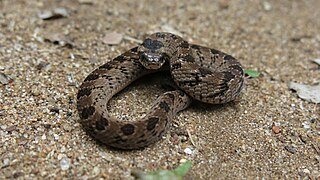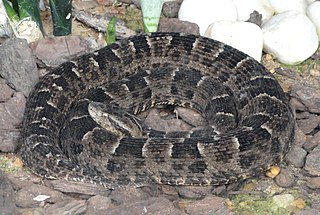
Bothrops alternatus is a venomous pit viper species found in South America. Within its range, it is an important cause of snakebite. The specific name, alternatus, which is Latin for "alternating", is apparently a reference to the staggered markings along the body. No subspecies are currently recognized.
Atheris rungweensis is a venomous viper subspecies endemic to Africa in Tanzania, Zambia and Malawi. It was formerly considered a subspecies of Atheris nitschei.

Causus defilippii is a species of venomous snake in the family Viperidae. The species is endemic to East Africa. There are no recognized subspecies. Its common name is snouted night adder.

Bothriechis aurifer is a venomous pit viper species found in Mexico and Guatemala. No subspecies are currently recognized.
The water python is a non-venomous python species found in Australia and Papua New Guinea. No subspecies are currently recognized.

Bothrops neuwiedi is a highly venomous pit viper species endemic to South America. This relatively small snake has a wide range and is a major source of snakebite in Argentina. It was named after German naturalist Prince Maximilian of Wied-Neuwied (1782-1867), who made important collections in Brazil (1815-1817). Seven subspecies are currently recognized, including the nominate subspecies described here.

Ovophis okinavensis is a venomous pitviper species found in the Ryukyu Islands of Japan. No subspecies are currently recognized.

Bothrops bilineatus is a venomous pitviper species found in the Amazon region of South America. A pale green arboreal species that may reach 1 m (3.3 ft) in length, it is an important cause of snakebite throughout the entire Amazon region. Two subspecies are currently recognized, including the nominate subspecies described here.
Gloydius intermedius is a venomous pitviper species endemic to northern Asia. Three subspecies are currently recognized, including the nominate subspecies described here.
Gloydius monticola is a venomous pitviper species endemic to southern China. A small and darkly colored snake with no visible color pattern, it is found high in the mountains of northern Yunnan province. No subspecies are currently recognized.
Gloydius strauchi is a venomous pitviper species endemic to western China. It is a small snake with a pattern of four longitudinal stripes, although some older specimens may be a uniform black. Gloydius strauchi may be distinguished from G. monticola by its higher midbody dorsal scale count. This species jointly holds the altitude record for pitvipers together with Crotalus triseriatus of Mexico, both being found even above the tree line at over 4,000 m (13,000 ft). No subspecies are currently recognized.

Gloydius ussuriensis is a venomous pitviper species endemic to far east Russia, northeastern China and the Korean Peninsula. No subspecies are currently recognized.
Gloydius brevicaudus is a venomous pitviper subspecies endemic to China and the Korean Peninsula.
Bothrops medusa is a venomous pitviper species found in Venezuela. No subspecies are currently recognized.

Bothrops oligolepis is a venomous pitviper species found in Peru and Bolivia. The specific name is derived from the Greek words oligo and lepis, meaning "few scales"; probably an allusion to the lower numbers of dorsal and ventral scales that it has compared to B. bilineatus. No subspecies are currently recognized.
Bothrops pulcher is a venomous pitviper species found in South America. The specific name is Latin, meaning "beautiful", in reference to the color pattern. No subspecies are currently recognized.
Bothrops punctatus is a venomous pitviper species found in South America and Panama. No subspecies are currently recognized.

Bothrops bilineatus smaragdinus is a venomous pitviper subspecies found in the northern and western Amazon region of South America.

Bothrops brazili is a venomous pitviper species endemic to South America. No subspecies are currently recognized.
Bothrocophias campbelli, commonly known as Campbell's toadheaded viper or the Ecuadorian toadheaded pitviper, is a species of venomous pitviper in the family Viperidae. The species is endemic to South America. No subspecies are currently recognized.









